|
|
|
Sort Order |
|
|
|
Items / Page
|
|
|
|
|
|
|
| Srl | Item |
| 1 |
ID:
154988
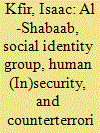

|
|
|
|
|
| Summary/Abstract |
This article examines the link between human security, social identity, and al-Shabaab. The first section explores how social identity group theory can help explain al-Shabaab's recruitment. The second part focuses on the counterterrorism campaign against al-Shabaab, which involves decapitation, aggressive peacekeeping through a proxy in the shape of the African Union Mission in Somalia, and the role of a domestic de-radicalization program. The article concludes that al-Shabaab's allure is in decline and the group is facing internal turmoil, which makes its overtures toward the Islamic State of Iraq and the Levant very dangerous, as al-Shabaab could act as an effective conduit between the Arabian Peninsula and Africa.
|
|
|
|
|
|
|
|
|
|
|
|
|
|
|
|
| 2 |
ID:
154973
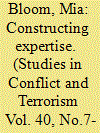

|
|
|
|
|
| Summary/Abstract |
The academic literature is divided with regard to whether terrorist recruits are dangerous masterminds, “malevolently creative,” and capable of perpetrating well-planned mass casualty attacks in the heart of European capitals. Or whether they are imbeciles, incapable of carrying out the most basic tasks, who mostly end up blowing themselves up by accident. This duality about the capabilities of terrorists is reflected in analyses of terrorist incidents. In fact, both depictions of terrorist recruits are accurate. Acuity and professionalism are not movement dependent (the same group may attract a variety of recruits) and might, instead, reflect a recruitment cycle that terrorist groups experience—one that alternates between labor-intensive and expertise-intensive periods of recruitment. The phases may shift because of external pressures (periods of territorial expansion/contraction) and opportunities (need for better quality recruits) with associated shifts in how groups use propaganda to attract a different quality of recruit during different periods of time. A possible first step toward hindering terrorist recruitment is to better understand the ways in which terrorist organizations work—where and when they recruit, whom they target, and the different propaganda messages used for selective/targeted recruitment. A clearer picture of the process could provide opportunities to counter a group's appeal, replenish their ranks, and inoculate vulnerable populations against recruitment. Case studies of three different terrorist organizations (Al Qaeda, the Islami State in Iraq and Syria [ISIS], and the Provisional Irish Republican Army [PIRA]) presented here posit that there exists a terrorism “recruitment cycle” that alternates between labor and expertise focus, uses different recruitment strategies and different propaganda messaging depending on this cycle.
|
|
|
|
|
|
|
|
|
|
|
|
|
|
|
|
| 3 |
ID:
154972
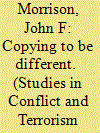

|
|
|
|
|
| Summary/Abstract |
While the impact of the Troubles retains centrality within much of Northern Irish political life, the spectre of almost daily violence is becoming a more distant memory. Peace has come to the region. In spite of this, however, there are those who wish to maintain the utility of violence to achieve their stated aims. Most dominant among these are the violent dissident republican groups. No longer is their existence solely defined by their desire to bring about a united Ireland. In order to have any opportunity of longevity, they must first legitimize their continued existence, and in turn distance themselves from their former Provisional comrades. This article assesses how groups, such as the Continuity Irish Republican Army (IRA), Óglaigh na hÉireann, and the IRA/New IRA utilize the lessons learned from their Provisional history to differentiate themselves from the politicized dominance of Sinn Féin. This evaluation is carried out through the analysis of interviews with leadership and rank and file members of both political and paramilitary dissident groupings, which is complemented by the analysis of the Violent Dissident Republican events database. These sources are supplemented with the assessment of organizational statements, from 2007 to the present day. The article focuses on violent, and nonviolent, learning.
|
|
|
|
|
|
|
|
|
|
|
|
|
|
|
|
| 4 |
ID:
154975


|
|
|
|
|
| Summary/Abstract |
Using the Islamic State in Iraq and al-Sham (ISIS) as a case study, we explore the process by which children evolve from novice recruits to fully fledged members of a violent extremist movement. From currently available data, we propose six stages of child socialization to ISIS—Seduction, Schooling, Selection, Subjugation, Specialization, and Stationing. Furthermore, we explore this process in the context of “Community of Practice” (COP) as developed by Wenger and Lave. COP models highlight how newcomers learn and pass through degrees of involvement from the periphery of an organization to the inside. In subsequent research, Hundeide highlighted how “contracts of deep commitment” and “conversion” constitute important social and psychological elements of communities of practice. We regard such qualities as intrinsic to children's involvement in ISIS. We conclude with implications drawn from the disengagement and reintegration experiences of former child soldiers in other contexts.
|
|
|
|
|
|
|
|
|
|
|
|
|
|
|
|
| 5 |
ID:
154970


|
|
|
|
|
| Summary/Abstract |
Violent nationalism in Northern Ireland has drawn inspiration from a tradition of physical-force republicanism that dates back centuries. The consequence has been a strong tendency for Irish republicans to draw on that history as a source of ideas for their conduct of campaigns of violence. However, during Northern Ireland's most recent Troubles from the late 1960s to the 1990s, external influence on the republican movement was evident in some of the tactics adopted and, even more strongly, in the turn toward negotiations. At the same time, Irish republicans have directly assisted other groups from Spain to South Africa in the employment of particular means such as the culvert bomb. But it is more striking that republicans have tended to eschew some of the means that have been widely associated with terrorism elsewhere since the 1960s such as the hijacking of aircraft for the taking of hostages. Transnational influences on Irish nationalists have been greater at the level of political ideas and as a source of legitimization than as a model for their own campaigns.
|
|
|
|
|
|
|
|
|
|
|
|
|
|
|
|
| 6 |
ID:
154986


|
|
|
|
|
| Summary/Abstract |
Do certain cultures or religions predispose citizens to support the deployment of torture against suspected terrorists? Based on an international survey of 31 different countries, we examine how religion and culture affect respondents' position on torture. We find that at the individual level, the nonreligious are resolutely opposed to torture, and that Christians, Buddhists, Hindus, Jews, and other faiths are more supportive. Among world cultures, Muslim/African cultures are most opposed to the torture of terrorists, while Confucian, English-speaking, and South Asian cultures are the most supportive of it. We also find that the use of torture has less support in countries that are suffering from terrorism, once religion and culture are considered.
|
|
|
|
|
|
|
|
|
|
|
|
|
|
|
|
| 7 |
ID:
154982
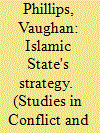

|
|
|
|
|
| Summary/Abstract |
To understand the Islamic State's strategy, we have to look at the way the group twins Maoist and post-Maoist strategies, previously considered strategically incompatible. By establishing a state that it claims to embody the Caliphate, it not only gains revenue and resources, but also generates a seductive “brand” with a compelling message that it “sells” via the Internet. This brand, based on Propaganda of the Deed, synergizes its physical and digital activities to create a virtuous circle that is very close to being self-sustaining. As such it represents a new insurgent model that corroborates the News Wars thesis.
|
|
|
|
|
|
|
|
|
|
|
|
|
|
|
|
| 8 |
ID:
154976


|
|
|
|
|
| Summary/Abstract |
Daesh fighters have taken hostage over 100 foreigners in Syria, Iraq, and elsewhere since 2012. The kidnappings drew international attention in August 2014, when American journalist James Foley was decapitated and a video of his death was posted online. But the pattern of kidnappings and gruesome videos distributed by violent Salafi-jihadists extends back over a decade to the killing of Daniel Pearl in 2002. This article traces shifts in the strategic rationale of Al Qaeda and Daesh for beheading Western hostages. It argues that terrorists altered their calculations on foreign hostages beginning in 2012 and U.S. counterterrorism policy does not take these shifts into account.
|
|
|
|
|
|
|
|
|
|
|
|
|
|
|
|
| 9 |
ID:
154974


|
|
|
|
|
| Summary/Abstract |
The importance of understanding how terrorist organizations learn and innovate cannot be overstated. Yet there is a remarkable paucity of literature systematically addressing this subject. This article contributes to an evolving conceptualization in this area by proposing a preliminary typology of learning and innovation as undertaken by modern jihadist groups. It identifies and discusses four categories: (a) intergroup learning within a single domestic setting; (b) intergroup learning between two or more local groups across a state or national boundary; (c) intergroup learning between a transnational group and one or more domestic groups; and finally (d) intragroup learning or “self-learning.”
|
|
|
|
|
|
|
|
|
|
|
|
|
|
|
|
| 10 |
ID:
154979


|
|
|
|
|
| Summary/Abstract |
This article examines the rise and subsequent development and transformation of the new radical right movement in Denmark from 1980–2015. The Danish radical right emerged from xenophobic subcultures as a reaction to increasing immigration during the 1980s and evolved into a social movement of nationalist associations, militant skinheads, and neo-Nazis that attempted to conquer the streets. This attempt was met by an antiracist countermovement, which built up a coalition of left-wing militants and moderate political organizations that put a temporary end to the radical right as a social movement during the second half of the 1990s. However, from 2001 national and international circumstances offered new opportunities for the Danish radical right both in the streets and as a parliamentary voice.
|
|
|
|
|
|
|
|
|
|
|
|
|
|
|
|
| 11 |
ID:
154977


|
|
|
|
|
| Summary/Abstract |
Political assassinations can dramatically impact political and social dynamics, especially in times of violent political conflicts or electoral competition. The current study explores if and how specific social and political events facilitate the occurrence of political assassinations. After an examination of the logic of political assassinations, a theoretical framework is presented, which explains the role of civil wars and electoral processes as facilitators of different types of political assassinations. The theory is tested via a dataset of political assassinations worldwide between the years 1946–2013. The findings confirm that different sets of structural and contextual factors facilitate assassinations against heads of state, legislators, and leaders of opposition movements/parties. In addition, the findings illustrate the tendency of elections, especially in nonliberal settings and in polarized societies, to facilitate political assassinations rather than to calm the political environment. In contrast, civil wars have a more limited impact on the probability of assassinations, and their intensity and endurance mainly enhance the risk of assassinations of legislators.
|
|
|
|
|
|
|
|
|
|
|
|
|
|
|
|
| 12 |
ID:
154978


|
|
|
|
|
| Summary/Abstract |
This study characterizes trends in the frequency and characteristics of terrorist attacks in child-serving educational institutions around the world, examining the specific vulnerabilies of children and schools with regard to terrorist violence, as well as the various impacts that violence has on children, communities, and societies. Following the analysis of available data on terrorist attacks against educational institutions, vulnerabilities, and impacts, the study concludes with a discussion of what still needs to be understood in the intersection of child vulnerability and terrorism, and provides recommendations for improving resilience to terrorist attacks against child-serving educational institutions.
|
|
|
|
|
|
|
|
|
|
|
|
|
|
|
|
| 13 |
ID:
154971


|
|
|
|
|
| Summary/Abstract |
This article provides an overview of Provisional Irish Republican Army (PIRA) innovations with regards to improvised explosive devices (IEDs). It situates PIRA's tactical innovations within the broad organizational psychology literature focused on the nature and drivers of creativity and innovation. This discussion helps frame the two empirical analyses that follow. The first analysis provides a graphical timeline of PIRA's radical innovations (and their drivers) in relation to IED technology. This helps provide a sense of the specific occasions in which PIRA innovations were numerous and when they were sparse. The second analysis looks at the locations in which PIRA radical innovations debuted. This provides us with an understanding of the specific PIRA units responsible for these innovations. The results demonstrate that while PIRA operations spanned the six counties of Northern Ireland for 29 years, radical IED innovations were conceived, developed, and initially implemented within only two areas of operations for only seven of those years.
|
|
|
|
|
|
|
|
|
|
|
|
|
|
|
|
| 14 |
ID:
154968


|
|
|
|
|
| Summary/Abstract |
Terrorists learn every day to gain further knowledge on how to achieve their violent objectives. Consequently, understanding terrorist learning forms a crucial part of the fight to counter terrorism. However, while existing literature within terrorism studies has examined a number of different parts of the learning process, there currently fails to exist a comprehensive framework to encompass the learning process as a whole. This article will rectify this oversight by drawing on wider learning literature to develop a new analytical framework for terrorist learning that provides a definition, considers the actors involved and identifies processes and outcomes. Consequently, the full landscape of current and potential research in this important area is revealed.
|
|
|
|
|
|
|
|
|
|
|
|
|
|
|
|
| 15 |
ID:
154969
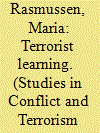

|
|
|
|
|
| Summary/Abstract |
This article studies the epidemic of kidnappings across six countries between 1968 and 1990. The goal is to identify those factors that determine the operational decisions made by terrorists. Why and how do terrorists decide to engage in certain types of actions but not others? The article discusses a number of scholarly approaches, and the variables these studies have put forward to explain the decision-making processes within terrorist organizations. The argument made here is that the groups' ideological preferences, strategic analysis, and need to attract media attention did not appear to exert much influence in the terrorists' decision to kidnap. Organizational resources and the nature of the security environment in which the terrorists operated had some bearing. However, kidnappings became attractive when terrorists made a pragmatic evaluation of the reaction by governments and the public and consequently of the costs or benefits of a particular course of action. The decision to carry out a campaign of kidnappings, or to abstain from kidnapping, should be interpreted as clear evidence of terrorist learning. Two types of learning appear to have influenced the adoption of kidnappings: learning by observing others and learning by doing.
|
|
|
|
|
|
|
|
|
|
|
|
|
|
|
|
| 16 |
ID:
154995
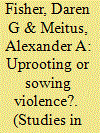

|
|
|
|
|
| Summary/Abstract |
Belligerent nonstate actors including terrorist organizations often exploit illicit economies to fund their activities. In Colombia numerous belligerent groups are involved in illegal narcotics markets. For more than 20 years, the Colombian government has responded with targeted eradication of illicit crops, intending to undermine the groups' sources of revenue while simultaneously disrupting the illicit drug economy. Despite its duration, this policy's effect on guerrilla violence remains unclear. Examining the potential for violent backlash to these tactics, this research note assesses the impact of aerial coca crop eradication in Colombia from 2004–2005 on domestic Colombian guerrilla kidnappings, assassinations, and terrorism.
|
|
|
|
|
|
|
|
|
|
|
|
|
|
|
|
|
|
|
|
|